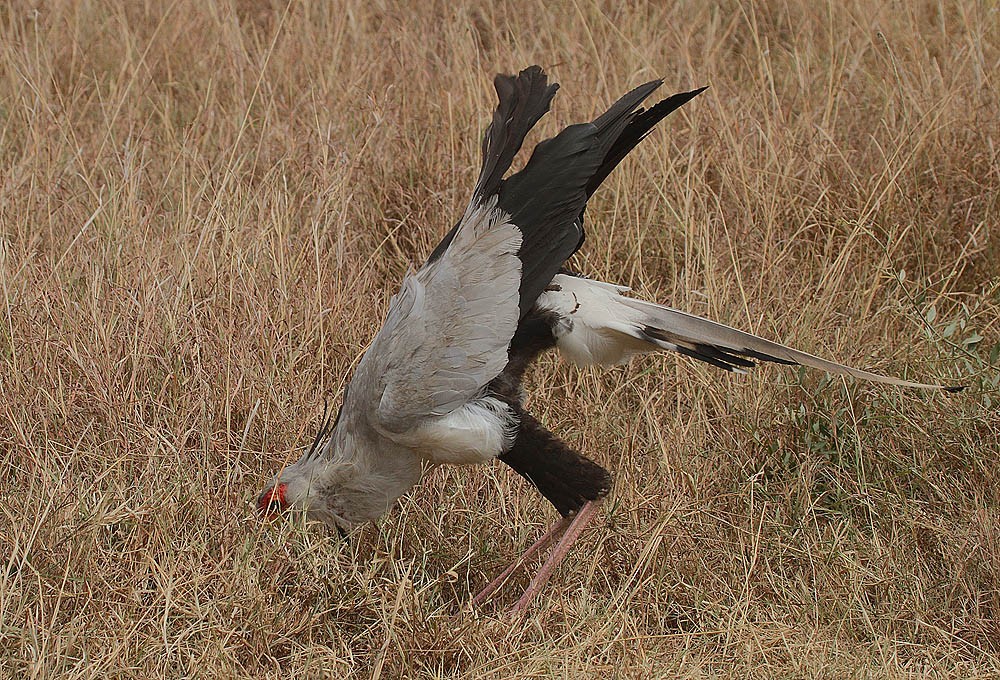Secretarybird
A species of Secretarybird Scientific name : Sagittarius serpentarius Genus : Secretarybird
Secretarybird, A species of Secretarybird
Botanical name: Sagittarius serpentarius
Genus: Secretarybird
Content
Description People often ask General Info
 Photo By Steve Garvie , used under CC-BY-SA-2.0 /Cropped and compressed from original
Photo By Steve Garvie , used under CC-BY-SA-2.0 /Cropped and compressed from original Description
Secretarybird(Sagittarius serpentarius) is a distinctive and large bird of prey found in Africa. Its taxonomic name means the archer of snakes since it's well-known for hunting snakes. With a height of more than 1.2 m, it has the longest legs of any other prey bird and always prefer to walk than fly.
Size
1.5 m
Colors
Black
Gray
White
Life Expectancy
18 years
Nest Placement
Ground
Feeding Habits
Secretarybird consumes insects, mammals, reptiles, birds, and eggs, but not carrion. Hunts on foot with unique stomping technique to flush and kill prey, sometimes employing aerial tactics with snakes. Physiologically adapted, with a short digestive tract and powerful, precise strikes, secretarybird swallows food whole and regurgitates indigestible parts.
Habitat
The secretarybird is indigenous to the vast open terrains of sub-Saharan Africa, predominantly inhabiting grasslands, savannas, and shrublands with sparse grass under 0.5 m to facilitate its hunting lifestyle. It thrives in these habitats up to elevations of 3150 m, utilizing scattered acacia trees for nesting and roosting. Adapted for life in open environments, secretarybird avoids tall grass over 1 m, dense woodlands, and deserts, suggesting a preference for moderate climates and avoiding extreme heat.
Dite type
Carnivorous
People often ask
General Info
Feeding Habits
Bird food type
Behavior
Secretarybirds are not generally gregarious aside from pairs and their offspring. They usually roost in trees of the genus Acacia or Balanites, or even introduced pine trees in South Africa. They set off 1–2 hours after dawn, generally after spending some time preening. Mated pairs roost together but may forage separately, though often remaining in sight of one another. They pace around at a speed of 2.5–3 km/h (1.6–1.9 mph), taking 120 steps per minute on average. After spending much of the day on the ground, secretarybirds return at dusk, moving downwind before flying in upwind. Birds encountered singly are often unattached males, their territories generally in less suitable areas. Conversely, larger groups of up to 50 individuals may be present at an area with a localised resource such as a waterhole in a dry area or an irruption of rodents or locusts fleeing a fire. Secretarybirds soar with their primary feathers splayed to manage turbulence. Their wings can flap, though in a slow laborious manner and requiring uplift to be sustained, otherwise they can become exhausted. In the heat of the day, they use thermals to rise up to 3,800 m (12,500 ft) above the ground. The lifespan is thought to be 10 to 15 years in the wild, with the oldest confirmed by banding to be 5 years from a nestling banded on 23 July 2011 in Bloemfontein and recovered 440 km (270 mi) away in Mpumalanga on 7 June 2016, and up to 19 years in captivity. 
Distribution Area
The secretarybird is endemic to sub-Saharan Africa and is generally non-migratory, though it may be locally nomadic as it follows rainfall and the resulting abundance of prey. Its range extends from Senegal to Somalia and south to Cape Province, South Africa. The species is also found at a variety of elevations, from the coastal plains to the highlands. The secretarybird prefers open grasslands, savannas and shrubland (Karoo) rather than forests and dense shrubbery that may impede its cursorial existence. More specifically, it prefers areas with grass under 0.5 m (1 ft 8 in) high and avoids those with grass over 1 m (3 ft 3 in) high. It is rarer in grasslands in northern parts of its range that otherwise appear similar to areas in southern Africa where it is abundant, suggesting it may avoid hotter regions. It also avoids deserts. 
Species Status
In 1968 the species became protected under the African Convention on the Conservation of Nature and Natural Resources. The International Union for the Conservation of Nature (IUCN) listed the secretarybird in 2016 as a vulnerable species, due to a recent rapid decline across its entire range. Although widespread, the species is thinly distributed across its range; its population has been estimated in 2016 to be anywhere between 6,700 and 67,000 individuals. Long term monitoring across South Africa between 1987 and 2013 has shown that populations have declined across the country, even in protected areas such as Kruger National Park due to bush encroachment, an increase in the tall vegetation cover, resulting in loss of open habitat that the species prefers. As a population, the secretarybird is mainly threatened by loss of habitat due to fragmentation by roads and development and overgrazing of grasslands by livestock. Some adaptation to altered areas has been recorded but the trend is for decline. 